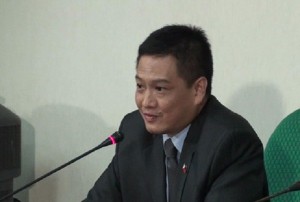Eleven years after the government absorbed P800 billion worth of debt with the privatization of the National Power Corp. (Napocor), a lawmaker on Wednesday said the government had made a mistake in ceding control of the country’s power supply to private companies.
It’s time the government returned to the business of power generation as a long-term solution to the power crisis, said Quezon Representative Lorenzo Tañada III.
“It is about time that we realize that the insecurity of our power system is the result of a structural defect introduced by the Electric Power Industry Reform Act (Epira). I believe that it was grave error for Epira, as envisioned and implemented, to have removed government role in power generation in a liberalized setting,” said Tañada who is the House deputy majority leader.
Tañada made the remarks ahead of the power summit scheduled to convene in Mindanao on Friday where Energy Secretary Jose Rene Almendras is expected to come under fire for his recent decision to allow a P14 per kilowatt hour (kWh) power rate hike in the region, with a directive ordering electric cooperatives to buy additional power supply from private power plants.
Tañada said the dismantling of Napocor’s power monopoly has inevitably led to “market failures” as seen in the prevailing power crisis in Mindanao where household and businesses have been forced to pay higher electricity rates because of the failure of government planners to boost the island’s power supply despite warnings as early as two years ago.
“One aspect of it has to do with the inability of the private sector to meet the required capacity additions in a timely manner; another has to do with the private players overcoming uncertainties through consolidation of market power. Both have serious negative impact on supply security, affordability, and fairness of pricing,” he said.
According to Tañada, Congress passed Epira in 2001 in the belief that fostering market competition in power generation would eventually benefit consumers in the form of lower prices. Full privatization of the state’s power generation assets has been much delayed, however, with only 70 percent of the state generator Napocor’s assets privatized by 2008.
He now believes that “the time is ripe” for government to re-enter the business of power generation.
‘Gov’t as player’
“By this, I do not mean a throwback to the former nationalized structure of generation. Instead, I envision a re-entry where government will be a player in generation alongside private corporations. This will give us the flexibility to respond to situations when markets fail, or when strategic public interest is not adequately served by the private sector,” said Tañada.
He explained that the government’s return to power generation would not require special legislation or even the grant of emergency powers to the Executive as Epira does not prohibit the government from participating in the liberalized generation sector outside of Napocor.
This will mean identifying a corporate vehicle to handle the government’s re-entry into power generation, with the Agus and Pulangui power facilities as its starting assets, as well as the Caliraya-Botocan-Kalayaan (CBK) facility, identified as a critical asset for the stabilization of the Luzon grid.
Democrito Mendoza, president of the Trade Union Congress of the Philippines, yesterday expressed concern over Almendras’ near-term solutions to the Mindanao power crisis in which electric cooperatives have been forced to buy expensive power from the Aboitiz Group’s Therma Marine power barges, which he said would hurt the region’s poor provinces.
He questioned why Almendras was so quick to bully the electric cooperatives into buying power from Therma Marine rather than force Aboitiz to “moderate its financial acquisitiveness” and lower its charges from P14 to P8 per kwh.
He warned the increase in power rates would tie up the region with the prohibitive tariff even as power supply from the cheaper hydropower plants would come onstream next year. With Jerome Aning
